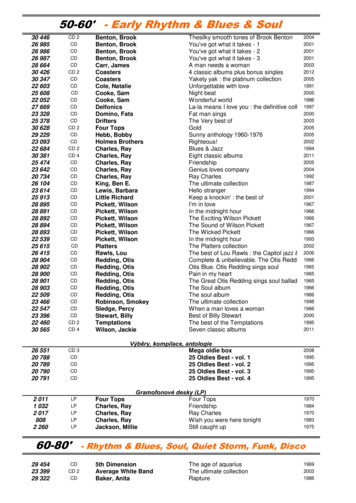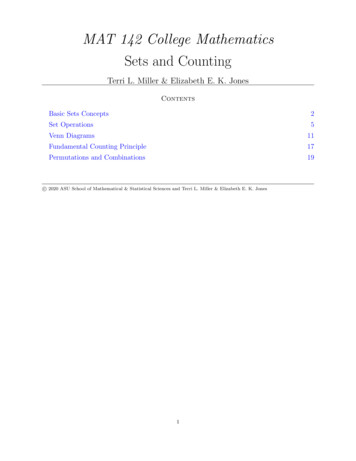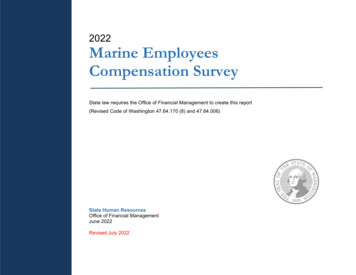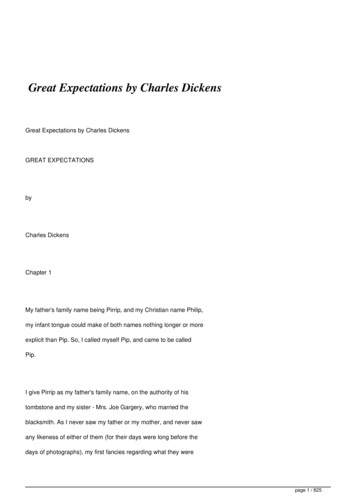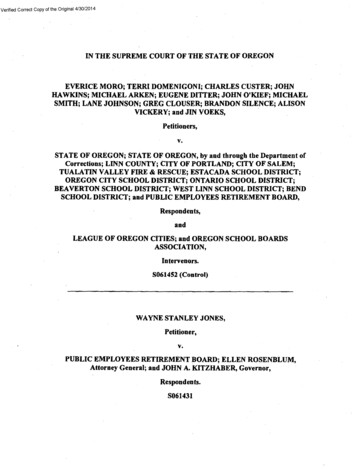
Transcription
Verified Correct Copy of the Original 4/30/2014IN THE SUPREME COURT OF THE STATE OF OREGONEVERICE MORO; TERRI DOMENIGONI; CHARLES CUSTER; JOHNHAWKINS; MICHAEL ARKEN; EUGENE DITTER; JOHN O'KIEF; MICHAELSMITH; LANE JOHNSON; GREG CLOUSER; BRANDON SILENCE; ALISONVICKERY; and JIN VOEKS,Petitioners,V.STATE OF OREGON; STATE OF OREGON, by and through the Department ofCorrections; LINN COUNTY; CITY OF PORTLAND; CITY OF SALEM;TUALATIN VALLEY FIRE & RESCUE; ESTACADA SCHOOL DISTRICT;OREGON CITY SCHOOL DISTRICT; ONTARIO SCHOOL DISTRICT;BEAVERTON SCHOOL DISTRICT; WEST LINN SCHOOL DISTRICT; BENDSCHOOL DISTRICT; and PUBLIC EMPLOYEES RETIREMENT BOARD,Respondents,andLEAGUE OF OREGON CITIES; and OREGON SCHOOL BOARDSASSOCIATION,Intervenors.S061452 (Control)WAYNE STANLEY JONES,Petitioner,V.PUBLIC EMPLOYEES RETIREMENT BOARD; ELLEN ROSENBLUM,Attorney General; and JOHN A. KITZHABER, Governor,Respondents.S061431
MICHAEL D. REYNOLDS,Petitioner,V.PUBLIC EMPLOYEES RETIREMENT BOARD, State of Oregon; and JOHN A.KITZHABER, Governor, State of Oregon,Respondents.S061454GEORGE A. RIEMER,Petitioner,V.STATE OF OREGON; OREGON GOVERNOR JOHN KITZHABER; OREGONATTORNEY GENERAL ELLEN ROSENBLUM; OREGON PUBLICEMPLOYEES RETIREMENT BOARD; and OREGON PUBLIC EMPLOYEESRETIREMENT SYSTEM,Respondents.S061475 & S061860SPECIAL MASTER'S FINAL REPORTAND RECOMMENDED FINDINGS OF FACT
TABLE OF CONTENTS .I:Introduction .:. 1II.Summary of Claims and Defenses .:. 2A. Petitioners' Claims . 2B. Respondents'/Intervenors' Defenses . 5III :Summary of Fact Finding Procedures . 6IV.PERS OVERVIEW . 8V.PERS STATUS BEFORE THE 2013 LEGISLATION .1 IA. Status at the Time of the Strunk Litigation . I 1B. System Chan ges Atter Strunk . 111. Oregon Public Service Retirement Plan (OPSRP) . 112. Imp act of the Tndividual Account Program (IAP) . 123. Side Accounts . 134. Rate Collaring .:.:. 155. Eamt , Fundin g, and Employer Contribution Rates . 176. The irect of the 2008 Recession . 197. 2013 Changes to Actuarial Methods and Assumptions . 20C. History of Relevant Provisions Affected by the 2013 Legislation . 221. Cost of Livin g Ad ustment (COLA)222. SB 656/HB 3349 enefits . 25.VI:THE 2013 LEGISLATION: SB 822 AND SB 861 . 26A. Before Enactment: The December 31, 2011 Actuarial Valuation, OtherActuarial Estimates, and PERS' Analysis of Possible Legislative Concepts. 26B. Enactment of SB 822 and SB 861 . 301. Sunun ary of the Legislation . p .Y . 302. Effect of SB 822 and SB 861 on Em lo er Rates and UAL . 323. Effect of SB 822 and SB 861 on Benefits . 35VII. . PUBLIC PURPOSE DEFENSE . 38A. Economic Conditions In General . 40B. Public School Financin g .:.C. Perceived Need for PERS Reform . :. 451. Relative Financial Condition of Oregon's Public Pension System . 452. Governor's Office Perception .:. 152D. Summ ary of Expert Opinions . 551. John Tapogna . . . 552. Thomas Potiowsky . 57.VIII. PETITIONER-SPECIFIC INFORMATION . 58A. Moro Petitioners .:. . 601. Everice Moro . .602. Terri Domenigoni . 613. Charles Custer . 624. John Hawkins . 63Page 1
5. Michael Arken . 646. Eugene Ditter .:. 657. John O'Kief . 668. Michael Smith . . 679. Lane Johnson . 6810. Greg Clouser . 6911. Brandon Silence . 7012. Alison Vickery . . 7113. Jin Voeks . . . . 72B. Self-Represented Petitioners . . 731. Wayne Stanley Jones . 732. Michael D. Reynolds . 753. George A. Riemer . 79IX.RESPONDENT-SPECIFIC INFORMATION . 81A. School District Respondents . 81B. Linn County. . . . 88C. Tualatin Valley Fire & Rescue . 89D. City of Portland . 90X.CONCLUSION.:.:. 92Page ii
I. IntroductionPetitioners in these consolidated cases have filed pctitions and amended petitionsfor review in the Oregon Supreme Court challenging the validity of certain parts ofOregon Laws 2013, chapter 53 (SB 822) and Oregon Laws 2013 Special Session, chapter2(SB 861). The petitions were all filed directly in the Oregon Supreme Court pursuantto section 19 of SB 822 and section 11 of SB 861. The court consolidated the cases forpurposes of judicial review, and appointed the undersigned as Special Master to compilea record, hold an evidentiary hearing, and make recommended findings of fact for theconsolidated cases.The Public Employees Retirement System (PERS) is complex. It was described indetail in Strunk v. PERB, 338 Or 145 (2005), and in the Special Master's Written Reportand Recommended Findings of Fact dated April 8, 2004 ("the 2004 Special Master'sReport"). 1 The Supreme Court relied on and largely adopted the 2004 Special Master'sReport in Strunk. This report does not attempt to duplicate the work done in the Strunklitigation. Instead, this report adopts the 2004 Special Master's Report and supplementsit with additional findings that may be pertinent to the claims and defenses presented inthis litigation. 2 The 2004 Special Master's Report is included in the record as Ex. 15.The parties do not agree that the factual fmdings in this report are relevant or evennecessary to assist the Supreme Court in resolving the claims and defenses presented inthese consolidated cases.2
II. Summary of Claims and DefensesA. Petitioners' ClaimsPetitioners are all current or retired public employees and PERS members. 3Petitioners Everice Moro, Terri Domenigoni, Charles Custer, John Hawkins, MichaelArken, Eugene Ditter, John O'Kief, Michael Smith, Lane Johnson, Greg Clouser,Brandon Silence, Alison Vickery, and Jin Voeks ("the Moro petitioners") are representedby counsel. Petitioners Wayne Stanley Jones, Michael D. Reynolds, and George A.Riemer are self-represented litigants.Eleven of the Moro petitioners—all except petitioners Silence and Voeks—allegethat the changes to the annual Cost of Living Adjustment (COLA) to PERS benefits madeby sections 1 and 3 of SB 822, and Sections 1 and 8 of SB 861, unconstitutionally impairtheir employment contracts in violation of Article I, section 21 of the OregonConstitution (First Claim) and Article I, section 10, clause 1 of the United StatesConstitution (Second Claim). The same petitioners further allege that those COLAchanges amount to an unconstitutional taking of their property without just compensationin violation of Article I, section 18 of the Oregon Constitution (Third Claim), and breachtheir PERS contracts if not unconstitutional (Fourth Claim).Some petitioners are "Tier One" members, meaning they have been PERS memberssince before 1996. Some are "Tier Two" members, meaning they became PERSmembers on or after January 1, 1996 and before August 29, 2003. Pensions for Tier Oneand Tier Two members are governed by ORS chapter 238. The Oregon Public ServiceRetirement Plan (OPSRP) is the retirement plan for eligible public employees hired afterAugust 28, 2003. OPSRP pensions are governed by ORS chapter 238A. See ORS238.430; 238A.100. Some petitioners are eligible to participate in OPSRP.32
Petitioners Silence and Voeks allege that the COLA changes to OPSRP providedby sections 5 and 7 of SB 822, and sections 3 and 8 of SB 861 , unconstitutionally impairtheir employment contracts in violation of Article I, section 21 of the OregonConstitution (Fiffth Claim), and Article I, section 10, clause 1 of the United StatesConstitution (Sixth Claim). Petitioners Silence and Voeks further allege that thoseCOLA changes amount to an unconstitutional taking of their property without justeompensation in violation of Article I, section 18 of the Oregon Constitution (SeventhClaim), and breach their OPSRP contracts if not unconstitutional (Eighth Claim).Petitioners O'Kief and Smith allege that sections 11-17 of SB 822 change theiradditional benefits granted pursuant to 1991 Oregon Laws chapter 796 (SB 656) 4 in waysthat unconstitutionally impair their contracts with their public employers in violation ofThe parties do not agree on the characterization of those benefits. Petitioners call thebenefits under SB 656 and 1995 Or Laws, ch. 569 (HB 3349) "SB 656/HB 3349benefits." The State Respondents call them a"tax remedy." In Stovall v. State ofOregon, 324 Or 92 (1996), the Supreme Court explained that PERS benefits were exemptfrom state income taxes from 1945 until 1991. In 1991, after the United States SupremeCourt decided Davis v. Michigan Dept. of Treasury, 489 US 803 (1989), the legislaturepassed Oregon Laws 1991, chapter 823, which eliminated the state tax exemption.Stovall, 324 Or at 98-99 (describing history). In Hughes v. State ofOregon, 314 Or 1(1992), the Oregon Supreme Court held that Oregon Laws 1991, chapter 1, violatedArticle I, section 21, of the Oregon Constitution, and that section 3 of that law "breachedpetitioners' PERS contract insofar as it subjects to state taxation PERS retirementbenefits accrued or accruing for work performed before the effective date of that 1991legislation." Stovall, 324 Or at 99 (quoting Hughes, 314 Or at 36). The Stovall courtstated that SB 656 "provided for increased PERS benefits in lieu of the tax exemption"(324 Or at 102), and that HB 3349 "provided for increased compensation to PERSmembers as to whom the state had breached its contract to provide tax-free pensionbenefits." Id. at 104. This report uses the term "SB 656/1-113 3349 benefits" to describethe benefits at issue without deciding which party's characterization of those benefits ismore accurate.43
Article I, section 21 of the Oregon Constitution (Ninth Claim), and Article I, section 10,clause 1 of the United States Constitution (Tenth Claim). Petitioners O'Kief and Smithfurther allege that the changes to those benefits amount to an unconstitutional taking oftheir property without just cornpensation in violation of Article I, section 18 of theOregon Constitution (Eleventh Claim), and breach their PERS contracts if notunconstitutional (Twelfth Claim).Petitioners Jones, Reynolds, and Riemer ("the self-represented petitioners") join inthe Moro petitioners' claims, and they filed separate petitions alleging that SB 822 andSB 861 change their COLA and SB 656/HB 3349 benefits in ways that impair theircontracts with their public employers in violation of Article I, section 21 of the OregonConstitution, and Article I, section 10, clause I of the United States Constitution. Theself-represented petitioners also allege that SB 822 and SB 861 amount to anunconstitutional taking of their employment contracts with their public employers, andbreach their employment eontracts if not unconstitutional. Petitioner Reynolds alsoalleges,that the reduction of benefits provided by sections 11-16 of SB 822 violates 4USC § 1 l4(a), making those sections invalid under the Supremacy Clause, Article VI,clause 2 of the United States Constitution.Petitioner Riemer also alleges that SB 822 and SB 861 violate Article I, section 20of the Oregon Constitution by granting privileges to citizens and classes of citizens whichdo not equally belong to other citizens on the same terms. Riemer further alleges that SB822 and SB 861 violate section 1 of the 14 h Amendment to the United States4
Constitution by depriving Riemer of his property without due process of law and denyinghim the equal protection of the law.B. Respondents'/Intervenors' DefensesRespondents and Intervenors deny that SB 822 and SB 861 unconstitutionallyimpair or breach petitioners' contracts, or that they amount to an unconstitutional takingof petitioners' property. Respondents State of Oregon; Public Employees RetirementBoard; Governor John A. Kitzhaber; Attorney General Ellen Rosenblum; and the OregonPublic Employees Retirement System ("State Respondents") do not assert any affirmativedefensess The City of Portland; the City of Salem; the Beaverton School District; andIntervenor League of Oregon Cities do not assert any affinnative defenses, either.Respondent Tualatin Valley Fire & Rescue ("TVF&R") asserts the followingaffirmative defenses: (1) the court lacks subject matter jurisdiction to address claimsagainst TVF&R (First Defense); (2) the petitioners who worked for TVF&R—petitionersCuster and Ditter--have failed to state a claim for relief against TVF&R (SecondSIn their Answers to Petitions and Amended Petitions, State Respondents indicate as partof their "General Answer" that they "do no more than deny all of the petitioners' legalallegations concerning both SB 822 and SB 861 at this point. State Respondents deny allallegations that any provision of SB 822 or SB 861 impairs any obligation of contract inviolation of the Oregon or United States Constitutions. To the extent that SB 822 or SB861 does impair any obligation of contract, such impairment is not substantial, and is areasonable means to restrict parties to gains reasonably to be expected from any contract.And to the extent that there is any impairment, it is reasonable and necessary to serve alegitimate and significant public purpose, and is of a eharacter reasonable and appropriateto the public purpose behind the legislation." State Respondents' Answers, pp. 4-5. Intheir objections to the Special Master's Preliminary Report, State Respondents indicatethat the allegations quoted above are raised as "defenses'.' though they acknowledged thatthey do not assert any "affirmative defenses." State Respondents' Objections, pp. 6-7.
Defense); (3) the claims are barred by the applicable statute of limitations for actions onbreach of contract (Third Defense); and (4) the claims are barred by the applicable statuteof ultimate repose (Fourth Defense).Respondents Estacada School District, Oregon City School District, OntarioSchool District, West Linn School District, and Bend-LaPine School District ("theSchool District Respondents"), joined by respondent Linn County and intervenorsOregon School Board Association and Association of Oregon Counties, assert a"publicpurpose" defense to the Moro petitioners' claims. 6 Specifically, they allege that, if theOregon Supreme Court finds that SB 822 or SB 861 substantially impairs contractualrights in violation of the Oregon or United States Constitution, then the change tocontractual rights, caused by SB 822 or SB 861 is constitutional because it is justified bythe important, significant and legitimate public purpose of remedying a broad and generaleconomic problem, and the bills were reasonable and necessary to advance that publicinterest. 7III.Summary of Fact Finding ProceduresTo streamline the fact-finding process, the Special Master received affidavits anddeclarations from various witnesses in lieu of direct examination, and required that theThe 2004 Special Master's Report referred to a similar defense as an "economichardship" defense. The School District respondents, Linn County, Association of OregonCounties, and Oregon School Board Association objected to that label when it was usedin the Special Master's Preliminary Report. This report uses respondents/intervenors'preferred label for their defense without expressing any opinion as to the nature,characterization, or legal effect of that defense.6Intervenors Oregon School Board Association and Association of Oregon Cities assertthe same defense in answers to the claims asserted by the self-represented petitioners.76
declarants be made available for cross-examination upon request. The Special Mastertook additional testimony at an evidentiary hearing held on Apri12 d and 3 d, 2014, andreceived the following into evidence: Exhibits 1-80 from the petitioners; Exhibits S1-S27from the State Respondents; Exhibits SDLC 101- SDLC 109 from the School Districtrespondents, Linn County, and intervenors Association of Oregon Counties and OregonSchool Board Association; Exhibit P1 from the City of Portland; and Exhibit TVFR 1from TVF&R.g Before the evidentiary hearing, all parties were encouraged to stipulate tofacts that were not in dispute. The parties each submitted proposed stipulated facts andresponses to proposed stipulated facts.After the evidentiary hearing, the parties submitted supplemental proposedfmdings of fact and a set of Joint Stipulated Facts. The Special Master heard additionalargument on April 18, 2014. The Special Master then circulated a preliminary report tothe parties, considered any objections to the preliminary report, finalized the report, andsubmitted it to the Supreme Court.The "Explanatory Observations" at pages 1-4 ofthe 2004 Special Master's Reportapply equally here and are adopted and incorporated herein. In addition, I have receivedevidence into the record despite relevance objections by one or more of the parties, on thetheory that the Supreme Court will decide which evidence, i any, is relevant to itsreview. Intervenor League of Oregon Cities. asked me to malce only one factual finding:The transcript of the April 2-3 evidentiary hearing (cited as "TR") is included in therecord. Affter the evidentiary hearing, the Moro petitioners moved to supplement therecord to add Exhibit 81, the April 2014 issue of the PERS newsletter,"PERSPECTIVES." The Moro petitioners withdrew that request at the April 18 hearing.g7
that fact-finding was not necessary to resolve the petitions before the Supreme Court. Idecline to make that finding, leaving it to the Supreme Court to decide whether factfinding was necessary.This report does not attempt to summarize all the materials included in thelegislative history for SB 822 and SB 861, nor does it include statements in the legislativehistory for prior legislation affecting PERS. 9IV. PERS OVERVIEWThe genera) operation of the PERS system is described at pages 8-22 of the 2004Special Master's Report. This report supplements that description with the additionalfacts set forth in this section.The ultimate cost of PERS or any other pension plan is generally governed by thefollowing equation: Benefits Contributions Actual Investment Earnings: For PERS,the Oregon Legislature sets benefits, the PERS Board sets contributions, and ActualInvestment Earnings are investment returns on PERS assets, driven by the assetallocation determined by the Oregon Investment Council. The PERS Board hasconsistently elected to follow a.prudent path that attempts to balance at-times competingobjectives of contribution rate stability, restoring system funded status, andintergenerational equity. 10Legislative history materials for various PERS legislation enacted from 1971-2013 areincluded in the record as Exs. 50 through 60.910Joint Stipulated Facts, p. 4, ¶¶ 1, 2.8
The PERS Fund may have an unfunded actuarial liability (UAL) at any giventime. The UAL is the amount by which the actuarial accrued liability of the fund exceedsthe actuarial value of the fund's assets. The PERS Board can address the UAL byaffecting the amount of contributions through employer rates. Employer rates areexpressed as a percentage of salary paid to PERS-covered employees. The PERS Boardcan control the timing of contributions, not the ultimate total of necessary contributions.Employer rates are set by the PERS Board in consultation with the actuary to eliminatethe UAL over a certain amortization period (for the valuation pertinent to this litigation,20 years). i 1One component of the "Benefits Contributions Actual Investment Earnings"formula that can be changed to reduce the UAL is the cost of benefits to be paid. To havean appreciable effect on employer ratcs, benefit changes need to reduce the system'saccrued liability on an order of billions of dollars. 12As of December 31, 2011, 68 percent of the system's accrued liability was owedto mernbers who were no longer actively employed: 60 percent was owed to retiredmembers, and 8 percent to inactive members. Because a combined 68 perccnt of thesystem's accrued liability was attributable to members no longer employed, any "costcontainment" measure designed to address the system's UAL that did not include thesemembers would leave out a large segment of the members whose benefits were drivingJoint Stipulated Facts, p. 5, 15.12Joint Stipulated Facts, p. 8, ¶ 18.9
system costs. For example, proposals that only reduced benefits to be paid to activemembers in future years would place the entire burden of the cost reductions on membersrepresenting 32 percent of the accrued liability. Similarly, proposals to create anotherbenefit tier for new employees would not affect the existing UAL, because UALmeasures accrued benefits as of the valuation date. If the iegislature denied all retirementbenefits to new public employees, that would have no effect on the existing UAL. 13The PERS Board sets employer contribution rates biennially. Rates are based onactuarial valuations conducted with measurement dates in odd-numbered years. The ratesare actuarially calculated, using a variety of assumptions and methods. Theseassumptions include long-term investment return assumptions and life expectancy forretirees. The methods and assumptions used by the actuary are reviewed by the PERSBoard biennially. 14The PERS actuary calculates individual employer contribution rates for each ofthe hundreds of participating PERS employers. Periodic actuarial analysis presented tothe Board includes average rates on a system-wide basis. ls Throughout these findings offact, references to employer rates are to those system-wide employer rates unlessotherwise indicated.13Joint Stipulated Facts, p. 9, 119.14Joint Stipulated Facts, p. 5, 16.15Joint Stipulated Facts, p. 20, 112.10
V. PERS STATUS BEFORE THE 2013 LEGISLATIONA. Status at the Time of the Strunk LitigationThe status of the system before the enactment of the 2003 legislation and thechanges to the system following the 2003 PERS legislation that were at issue in Strunkare described in detail in the Supremc Court's opinion in Strunk and the 2004 SpecialMaster's Report. 16B. System Changes After Strunk1. Oregon Public Service Retirement Plan (OPSRP)OPSRP, described in ORS chapter 238A, is the retirement plan for all eligiblepublic employees hired after August 28, 2003. Although OPSRP was created as part ofthe 2003 PERS legislation, it was not challenged in Strunk. In general, a publicemployee who retires under OPSRP will receive a pension benefit under the PensionProgram described in ORS 238A.100 through 238A.250. This'pension benefit is a"defined benefit" plan. The retiree would also receive a"defined contribution benefit"under the Individual Account Program described in ORS 238A.300 through 238A.415.Since its creation in 2003, the number of OPSRP participants has steadily increased. ByDecember 31, 2012, of the 167,103 active participants in the system, 77,666 (46.47percent) participated in OPSRP. 17See 2004 Special Master's Report (Ex. 15), pp. 8-22 (describing general operation ofthe PERS system); pp. 22-59 (describing status of the PERS fund and events affecting thesystem before the 2003 legislation); pp. 59-73 (describing the 2003 PERS legislation andthe challenges asserted in Strunk).1617Joint Stipulated Facts, p. 19, 15.11
2. Impact of the Indfvfdual Account Program (IAP) 18Beginning January l, 2004 employee contributions were deposited to theiraccounts in the IAP rather than to Tier One and Tier Two employee accounts.Contributions to an employee's IAP account after January 1, 2004 are not available to fund Tier One and Tier Two retirement allowances. Tier One and Tier Two participantsreceive a new benefit—the balance of the IAP account upon retirement. By 2012, theaverage balance of those accounts had grown to 20,432. 19The 2004 Special Master's Report noted that the "diversion of inembercontributions to the IAP will reduce members' future account balances for purposes ofemployer matching under the Money Match formula." 20 The report predicted that, "[o]na system-wide basis, the elimination of employee contributions from the Money Matchcalculation probably will cause the Full Formula option to overtake the Money Match astlle most common retirement formula.s 21That prediction proved to be accurate. Since 2003, the percentage of retirementsunder the Money Match formula has diminished so that by 2012 it was no longer theretirement fornlula for the majority of new retirements. As of January 1, 2013, 50percent of new retirements were under the Fu11 Formula method, and 45 percent were18 This section primarily addresses the impact of the IAP on Tier One and Tier Twomembers. OPSRP members also participate in the IAP.19 Joint Stipulated Facts, pp. 18-19, 14.202004 Special Master's Report, p. 62.21 Id12
under the Money Match method. The remaining 5 percent retired under the Formulann method. ZZPlus-AuityThe ratio of a retiree's initial retirement bene'fit to his or her last salary beforeretirement is known as the "replacement ratio." PERS conducts a replacement ratio studyeach year, and publishes information from that study in a report titled "PERS: By TheNumbers." The 2012 study, summarized in the February 2014 "PERS: By TheNumbers," showed that the average replacement ratio was at its highest for retirees underthe Money Match formula in 2000. The average replacement ratio for Money Matchretirees has decreased since 2000. System-wide, the average replacement ratio for allretirees was at its highest, 68 percent, in 2002. By 2012, the average replacement ratiofor all retirees had decreased to 46 percent. For retirees with 30 years of service or more,the average replacement ratio was 100 percent in 2000; by 2012, that figure had declinedto 70 percent. 233. Side AccountsIn 2001, the legislature expressly authorized PERS participating employers toissue revenue bonds for the purpose of obtaining funds to pay a public employer's22Joint Stipulated Facts, p. 18, ¶ 4; Ex. 34, p. 7.23PERS: By The Numbers dated February 2014 is included in the record as Ex. 49. Thereplacement ratio study results are summarized on pages 4-5 of Ex. 49. The data reflectsthe results for the 72,453 retirements (drawn from 100,409 retirements from January1990 through December 20
defenses s The City of Portland; the City of Salem; the Beaverton School District; and Intervenor League of Oregon Cities do not assert any affinnative defenses, either. Respondent Tualatin Valley Fire & Rescue ("TVF&R") asserts the following affirmative defenses: (1) the court lacks subject matter jurisdiction to address claims

![The Book of the Damned, by Charles Fort, [1919], at sacred .](/img/24/book-of-the-damned.jpg)
